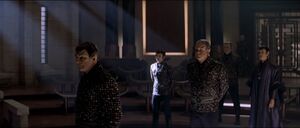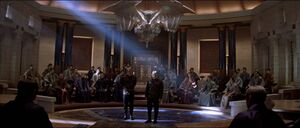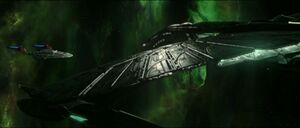Star Empire of Rator
- You may also be looking for the Old Romulan Star Empire, the Romulan Republic or the Romulan Free State

| |
| Romulan Star Empire | |
| Basic Information | |
| Major Species |
|
| Homeworld(s) |
|
| Founded |
2387 (Earth Year) |
| Warp Capable |
320 (Earth Year) |
| Official Language |
Romulan |
| Official Currency |
Takhse |
| Political Information | |
| Governance Type |
Republic |
| Leader |
|
| Military Branches |
|
| Template:Government | |
The Romulan Star Empire is one of the factions that arose from the collapse of the Old Romulan Star Empire after the Romulan supernova in 2387. Claiming to be the legitimate continuation of that government, it controls less than half of the previous territory, is no longer supported by the Tal Shiar, and with the loss of Romulus has been forced to establish its new Senate on the world of Rator III. Unlike the other states, the current Romulan Star Empire holds onto the traditions of the last 2,000 years and has remained largely unchanged in policies.
History
Before the Supernova (2380-2387)
The Romulan Senate was slow to acknowledge the reality of the impending supernova, and even slower to make necessary preparations. It was believed publicly acknowledging the disaster would cause chaos and the collapse of the Empire, and those in the know became embroiled in political manoeuvring to do what they felt was best either for the Empire or themselves.
As such, the Empire was not as prepared as it might have been for the Supernova. This was made worse by its reluctance to request or accept the aid of the Federation, which endangered the political standing of several senators, and was exacerbated by the Federation’s sudden withdrawal of aid in 2385. By this point, faith in the Romulan Senate across the Empire had all but collapsed, many regions making their own arrangements for protection and stability.
It was ultimately decided that the Romulan Senate, and all wings of the Romulan government, would relocate to Rator III. This was itself a politically fraught decision, with many of the core worlds expecting to benefit from the Senate’s relocation only for a far more distant system to be chosen. Rator III was notably a major holding for the Star Navy, perhaps the most important military world beyond Romulus itself, and it is assumed the Senate chose it to retain their loyalty. The region had also become more significant in the Empire over recent centuries, being closer to the old enemies of the Klingon Empire and active business of the Alpha and Beta Quadrants, and was thus much more the beating heart of everyday political and military activities than the core worlds.
But the damage was done. The Empire’s muddled and slow response to the supernova cost it the allegiance of many territories that felt abandoned and betrayed, while the relocation to Rator III secured major trade routes and military infrastructure at the cost of the former core worlds that resented the commensurate loss of prestige and government access. The final, crushing blow came shortly after the Senate’s relocation was deemed complete, and the Tal Shiar did not follow.
Re-establishment (2387-2393)
While key personnel were evacuated to Rator III prior to the supernova, vast archives, equipment, and staff never left Romulus. The reforming Senate scrabbled desperately to establish new government holdings, and did so largely under the loyal - and influential - eye of the Star Navy. Already, regional rulers were refusing to acknowledge the authority of the relocated Senate, including the governors of old core worlds who would unite to become the Romulan Free State, where the Tal Shiar had begun to sink its claws. The Star Navy guarded Rator and its surrounding territories, however, and even as the Empire fell into disarray, the Senate was still left with the largest stretch of systems and worlds that continued to owe it allegiance.
The Empire acted at once to retain its legitimacy. Governing documents were hastily and discreetly rewritten to allow efficient oversight over the territories it had, which often surrendered authority to the Star Navy on a temporary basis. Despite these emergency measures at first bearing little similarity to the government protocols of before, the Star Empire refused to publicly acknowledge this or even publish them, lest they appear as a whole new government, another pretender to the old empire’s territories. These measures nevertheless allowed the Star Navy to dispatch its forces across large stretches of the old empire, especially neighbouring regions that had not recognised the Senate’s continuing authority, and forcibly bring them to heel.
It did not yet dare contend with the Free State, which spent long years consolidating its assets before growing only slowly. The Star Empire condemned them as rebels and traitors, but soon its attention was drawn to perhaps a more dangerous rival: the nascent Romulan Republic. Born out of the fringes and borders with the Klingons and buoyed up by extensive naval defections, this was a truly reformist, democratic undertaking trying to offer a progressive future to the Romulan people. Several systems initially loyal to the Star Empire pledged allegiance to the Republic, its democratic ideas infesting territories mired in chaos and inhabited by a fearful people inspired by a message of hope and change.
This left the Star Empire struggling to retain territories on three fronts, with the Free State slowly expanding across the old core worlds, and the spinward borders the home of most of the minor, disparate factions springing up. These last were the weakest, and so the Star Navy dedicated much of its time bringing them to heel to strengthen the Empire in territory and prestige, with the view that this enhanced their legitimacy.
Rivals (2392 - 2394)
The same mistakes that had undermined the Romulan response to the supernova undermined the Empire’s efforts at re-establishment: a fear that overreacting to threats would make them seem weak. So it was that the Empire focused on reconquering - or, in their parlance, pacifying - minor factions, rather than decisively moving against the nascent Republic or the creeping expansion of the Free State. This left the Star Navy thinly-stretched across distant territories, forced to garrison regions that had once been peaceful, and all without the infrastructure that allowed them to quickly replace lost numbers.
These struggles, and the power of the Romulan Republic’s ideals, dealt the first blow to the Star Empire in its competitions with its rivals in 2392. Admiral Thalax, a charismatic and respected officer and commander of the 5th Fleet volunteered to lead his forces to subjugate the Republic, only to deliver utter embarrassment to the Star Empire when he and his entire task force subsequently defected. Thalax’s parting message to the Empire condemned it for seizing territory it could not hold and could not govern, and stated a new way forward for the Romulan people was necessary.
Confrontation with the Free State came a year later, when the Achernar System, nominally part of the Empire, pledged its allegiance to the rival power in response to this latest weakness. The Star Navy was immediately dispatched to bring them back into the fold, but with its forces thinly-stretched across distant territories, only an underpowered fleet could be mobilised in time. Arrogant admirals assumed this would suffice against the Free State and its Tal Shiar Navy, which had always been a small force and one they expected would struggle to protect all of its borders.
Had the Empire taken more time to consolidate its forces, it might have defeated the Free State at Achernar, but any delay was deemed a sign of weakness, especially after Thalax’s defection. Although the Tal Shiar Navy took considerable losses, the Star Navy’s fleet was ultimately routed, the Star Empire defeated by its upstart Tal Shiar-backed rivals. Worse, some in the Star Empire feared the Tal Shiar Navy had yet further assets, and that the Free State would continue its expansionist march.
There was bitter relief on Rator III when the Free State instead offered a treaty wherein they would fix their borders and cease any further expansion. Although this meant acknowledging the Free State’s territorial claims and treating it as another major power, not a rogue government, the Praetor ensured the Empire’s acceptance of the treaty framed the eventual reunification of the old empire as an inevitability - under the Rator Senate, of course. The Free State’s existential threat to the Star Empire was contained, at the loss of significant face for Rator and the acknowledgement of a rival as another Romulan government.
The Republic, meanwhile, had established treaties of cooperation with the Federation. While the Federation did not formally pledge to protect the Republic’s independence, the Star Empire knew it was in no state to earn their ire, especially with the Free State at this point in ascendance on the interstellar stage.
Return to Traditions (2394 - 2399)
These defeats nevertheless gave the Star Empire some breathing room. The Free State was no longer competing for territory and the Romulan Republic was pursuing a different path, rather than challenging the ascendancy of the Star Empire. Now the Star Empire’s challenges were internal, with senators eager to focus on the governance of the territories that they had.
For years they had chipped at the emergency powers that gave the Star Navy its influence, despising the idea of becoming a new form of government that could break their lineage from the Senate of Romulus. Original government policies and legislations were reinstated, however little they recognised the reality of the Star Empire’s present condition. What was important was that they continued to rule over the territories as they had for millennia, acting as if their losses were only a temporary setback instead of a fundamental change.
Perhaps the most outward-looking development was the paternalistic approach the Star Empire took towards the Romulan diaspora. While it lacked the resources to bring everyone back into the fold, it was the only Romulan faction that showed any true interest in conditions in the Neutral Zone, seeking allies in the region to both maintain control and security, and to uphold their legitimacy as the Romulan government.
With the Free State’s embarrassment and fall from grace after confronting Starfleet at Coppelius and the revelations of the Tal Shiar’s involvement in the Attack on Mars, the Star Empire has gone back on the political offensive. Relations between the Free State and the Federation have decidedly cooled, and into this rift the Star Empire has been eager to step, trying to establish itself as the Romulan faction with which other governments can, and should, do business and diplomacy.
Government
The Romulan Star Empire, despite its authoritarian nature, follows a republican structure of government, even after the reformed government settled on Rator III. Supreme authority is placed in a Senate composed of 44 members, which is overseen by a Praetor whom the Senate selects. Both Praetor and Senators serve until retirement or death.
Senators are selected by election or legislative appointment, however, following the Romulan supernova, there have been no new members elected to the Senate in order to stabilise and provide consistency within government. Most represent an entire Romulan world or systems. The Senate is responsible for setting legislation to decide all foreign and many domestic matters, while the execution of Romulan law is overseen by a series of Consuls, who are appointed on a basis of one per sector. The Proconsul directly controls this apparatus; while having no seat in the Senate, the position is viewed as an ideal stepping-stone to Praetorship. The Senate, and by extension the Praetor, has direct command over the fleet commanders and thus the Star Navy. This highly centralized command structure allows for smooth, efficient military operations.
An extension of the Senate is the Continuing Committee, an executive body headed by the Praetor which will at times meet separately from the Senate at large to decide matters of particular importance with speed. Previously, this has commonly been made up of Senators, though this is not a requirement and other high officials (such as the chairman of the Tal Shiar or, rarely, the Proconsul) may at times be appointed as well. The Praetor is the only permanent member of the Committee; all other members serve staggered eight-year terms, then must be reappointed by the other seven and confirmed by the Senate at large. The Commander of the Romulan Navy sits on the continuing committee due to the ongoing crisis following the supernova event.
All Romulan worlds are overseen by a governor. In the case of Romulan worlds, this official is elected and then confirmed by the Senate; for alien worlds, the governor is appointed by the Senate directly. Alien worlds, however, may use whatever political structure they possess to select a Viceroy to serve with the governor in a dual-executive capacity. The Viceroy need not be confirmed by the Senate, but the degree of power the office holds is dictated on a world-by-world basis by Senatorial edict. On some well-favored alien worlds, the Viceroy's power eclipses that of the governor; but on others, the office of Viceroy is essentially meaningless and the governor exercises complete control.
Life in the Romulan Star Empire
The Star Empire tries to present itself as the continuation of the government that ruled from Romulus for two thousand years. In practice, the only similarity is in legislation and ritual, with many of its Senators still holding office even as they once presided over the chaos of the supernova, which gives it a veneer of legitimacy but also serves as its weakness. Its government bureaucracy is woefully ill-equipped for the realities of its territorial holdings, resources, and military strength.
The Star Empire spends a considerable amount of time trying to bring rogue factions under control and keep the peace in the territories it holds but struggles to govern. Outsiders have viewed it as the last gasp of the old empire’s death, clinging to traditions as they pass into inefficiency and chaos, clutching territories it cannot keep because to let them go would be to accept the eventuality of their demise.
Citizens who live in the vicinity of Rator enjoy a life not that dissimilar to before the supernova, though with authority enforced by the Star Navy instead of the Tal Shiar. In times of peace, this has shown suggestions of more free-thinking among Imperial citizens as they question their best way forward, but when under threat the Star Empire always runs to the protective shroud of traditionalism.
Beyond those central worlds, regional governors have near-absolute power unless the Star Navy has a force in the area, as the Empire’s bureaucracy struggles, in practice, to enforce its rule. These local governments are often deeply authoritarian and highly corrupt. Life on the worlds which border other rogue Romulan factions, especially the smaller ones, is particularly dangerous. Governors either consider declaring independence, fear they will be accused of considering it and punished, or fear expansionist neighbours. Without the presence of the Star Navy and the stability it enforces, lives are cheap tools used to secure power and influence.
The Romulan Star Navy, better known to the Romulan people as the Galae Command, Imperial Command or the Romulan Guard, is a collection of warships and support craft that compose the Romulan Star Empire military, which is formally tasked with tactical and strategic missions at the Senate's discretion. Its authority is entirely logistical, however, as the Star Navy is controlled directly by either the Continuing Committee or the Senate at large, and within the military itself command is centralized at Galae Command on Rator III. The highest military position a Romulan can achieve is command of an Imperial Fleet -- one of the five fleets which make up the entire military force. However there are also sector commanders, also known as squadron commanders sometimes, which make for the major stepping stone to possibly achieving a position as a fleet commander. There is intentionally a great deal of overlap in these operating areas as this structure gives Romulan admirals considerable autonomy, they are expected to keep each other in check to a certain degree. The five Imperial Fleets are typically broken up into squadrons which are then broken up into wings. Each squadron will typically be assigned to a specific sector or area of operations.
All Romulans are required to perform service in some public institution or other, and the Star Navy's membership was thus - before the supernova - substantially larger than its Starfleet counterpart (though still slightly smaller than the Klingon Defense Force). Moreover, the political nature of the Star Navy's command structure tends to lend itself to maneuvering and power plays within and between military units; the Senate tolerates this as a means of honing its soldiers' skills, but looks very unkindly on any action that harms Romulan personnel, assets or interests. While it is not uncommon for political influence to dictate the assignment of certain officers, ranks are awarded on an entirely meritocratic basis; an older officer with a desirable assignment but low rank is not well looked upon.
Since the Romulan supernova, the Romulan Star Navy has continued to serve the Star Empire, with some elements of it defecting to the Romulan Republic over the years and significant losses suffered in the brief conflict with the Free State. They have also suffered from the inability to develop new ship classes due to limited resources, and have fielded the same military hardware for over a decade without innovation.
While the Star Empire holds fewer territories than before the supernova, the Navy’s numbers are reduced and the regions it does control are considerably more volatile. The Star Empire is also committed to bringing rogue factions under its control, though it has stopped acting directly against the Free State and Republic. There is always a push for more deployments to the spinward renegade factions, local warlords and clusters of allegiances trying to retain their own independence. Periodically, local governors of the Empire proclaim independence, and even loyal regions are heavily beset by instability, corruption, and piracy.
This has left the Star Empire thinly-stretched, forced to defend its territory and maintain stability in chaos, but repeatedly ordered to continue expanding in the Empire’s permanent quest for legitimacy. Such conflicting and difficult circumstances have often been the cited reason behind any Star Navy defections, often to the Republic. However, the Star Navy is the backbone of the Star Empire, and is highly proud of its role in upholding and preserving the government that stood for thousands of years and will, under their watchful eye, stand for thousands more.
In Play
- The Romulan Star Empire claims to be the continuation of the government from before the supernova, and acts accordingly. It is proud, desperate to restore its former glory, and views itself as superior to any other faction. But it knows its legitimacy is thin, and policy is largely driven by efforts to retain it.
- Bloated by ancient bureaucracy unfit for its present circumstances and with its navy stretched thin across chaotic territories, the Star Empire is perhaps the groaning last gasp of a dying government. It struggles to provide enough resources for all of its territories, and refuses innovation as a sign of weakness.
- Life outside of the central worlds is chaotic and dangerous, where local governors act often as warlords, corruption and piracy are rife, the Star Navy will maintain order at all costs, and regional factions vie for power or independence.
- It is the faction most interested in the old Neutral Zone, formally viewing these territories as part of its sphere of influence, and the protection and wellbeing of Romulans that reside there as its responsibility. It does not always meet these duties sincerely, sometimes crushing local chaos as a threat to its stability, or neglecting the diaspora if it cannot rally the resources.
- With the Free State a major faction on Star Trek: Picard and thus its present condition subject to change as the show continues, Bravo Fleet stories are more likely to use the Romulan Star Empire for any major and traditional Romulan stories.



